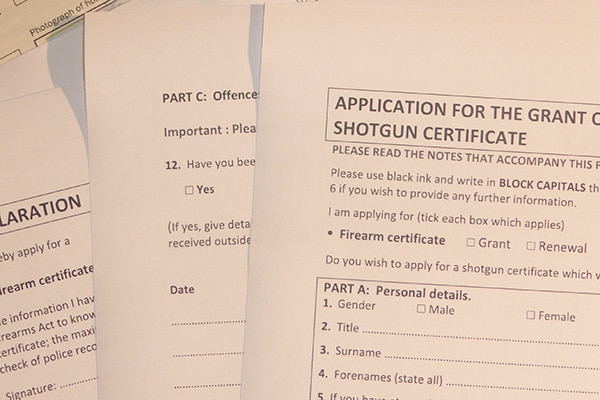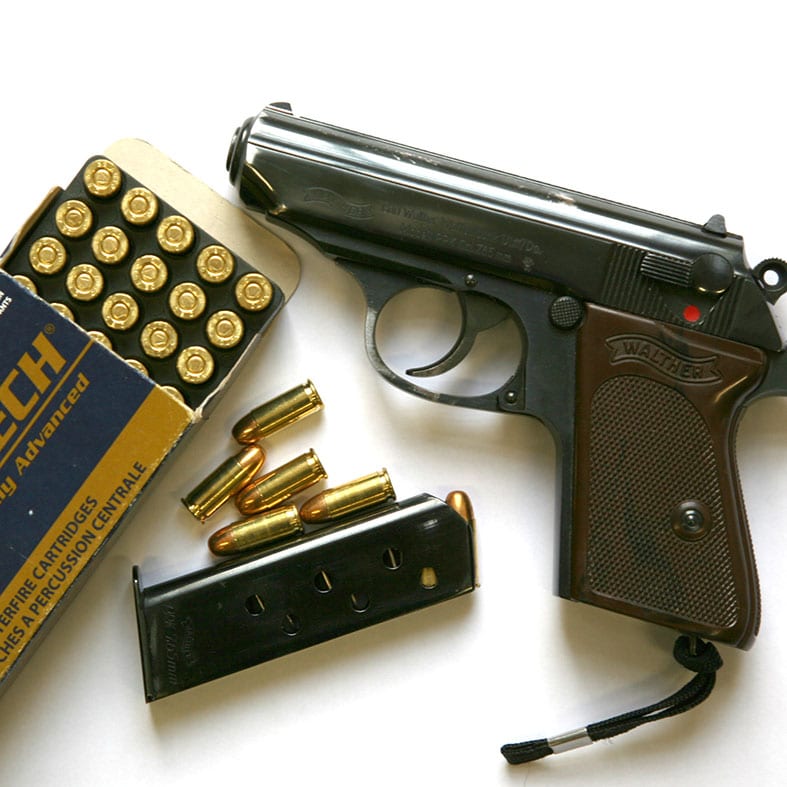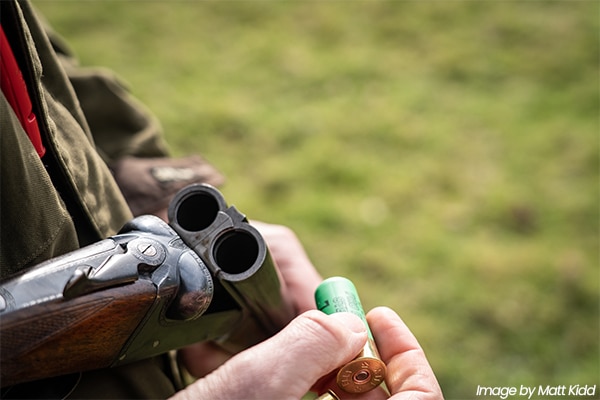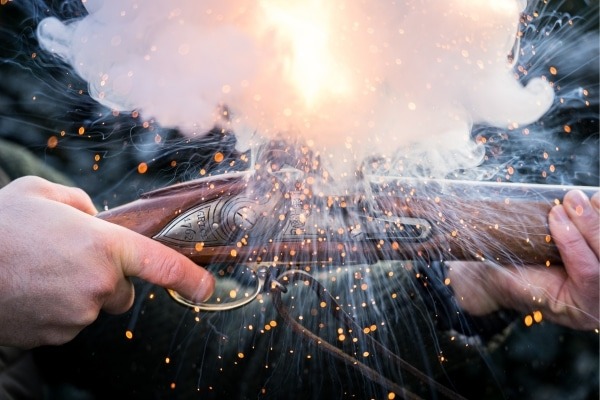
Certificate renewal flow chart
If your firearms certificate is due for renewal we’ve made it as easy as possible for you with a simple, easy to follow flow chart
Get information on the legal shooting season for mammals and birds in the UK.
Apply for funding for your project or make a donation today
Comprehensive information and advice from our specialist firearms team.
Everything you need to know about shotgun, rifle and airgun ammunition.
Find our up-to-date information, advice and links to government resources.
Everything you need to know on firearms law and licensing.
All the latest news and advice on general licences and how they affect you.


Handguns are not prohibited for the humane dispatch of deer by legislation in England, Wales or Scotland.
Legally the 1991 Deer Act (England & Wales) allows the use of handguns and their ammunition for the hunting of deer. The Deer (Scotland) Act 1996 and the Deer (Scotland) (Firearms Etc.) Order 1985 allows handguns to be used for the hunting of deer, but not ammunition due to a stated minimum muzzle energy and velocity.
However, police firearms licensing departments will refuse to entertain applications for handguns to hunt deer, as they are prohibited items within the meaning of the 1997 Firearms (Amendment) Act. Section 3 of the 1997 Act provides an exemption providing the firearm certificate is conditioned for the handgun to be used for the humane killing of animals alone.
Section 3 of the Firearms (Amendment) Act 1997 provides an exemption for handguns specifically for humane dispatch. The language of this section does not restrict the grant of a firearm certificate for a handgun for this purpose to any particular class of person, eg. professionals such as vets, etc.
Section 4 (2) of the Deer Act 1991 prohibits certain methods for the taking or killing or injuring deer. These are:
Schedule 2 of the Deer Act 1991 lists prohibited firearms and ammunition. These are:
NB: No.2 and 5 above says rifle and No.3 says air pistol; these do not include centrefire pistol calibre handguns or their ammunition.
Section 6 (3) & (4) of the Deer Act 1991 (amended by the Regulatory Reform (Deer) (England and Wales) Order 2007) allows for any reasonable method to be used for humane dispatch:
“(4) A person shall not be guilty of an offence under section 4(1) or (2) above by reason of the use of any reasonable means for the purpose of killing any deer if he reasonably believes that the deer has been so seriously injured, otherwise than by his unlawful act, or is in such condition, that to kill it is an act of mercy.”
“(4A) In subsection (4) above, “any reasonable means” means any method of killing a deer that can reasonably be expected to result in rapid loss of consciousness and death and which is appropriate in all the circumstances (including in particular what the deer is doing, its size, its distance from the closest position safely attainable by the person attempting to kill the deer and its position in relation to vegetative over).”
As handguns (short firearms) defined by Section 5(1)(aba) of the 1997 Firearms (Amendment) Act are not prohibited in Schedule 2 of the 1991 Deer Act, exemptions for short firearms do not feature within the main text of the Deer Act (ie. exemptions are only provided where prohibitions exist). Such short firearms may be legitimately employed within the meaning of Section 6(3), (4) & (4A) above.
The Deer (Scotland) Act 1996 and the Deer (Firearms etc.) (Scotland) Order 1985 have to be read in conjunction. The Order does not contain any specific prohibitions for handguns similarly to the Deer Act 1991.
The 1996 Act provides for ‘any’ method to be used for humane dispatch. A relevant extract from the 1996 Act is provided below. Full details of the 1985 Order are here [link www.legislation.gov.uk/uksi/1985/1168/contents/made]
Section 25 of the Deer (Scotland Act) 1996
The chief officer shall grant a certificate for a firearm if he is satisfied that:
The applicant must satisfy the chief officer that he has good reason to possess or acquire such a firearm.
The chief officer must take the case on its individual merits. Settled law constrains him from viewing the application from the standpoint of an objector. (Chapter 13.6 Firearms Law – Guidance to the Police: Home Office 2013. Anderson –v- Nielans 1940, Joy –v- Chief Constable Dumfries and Galloway Constabulary 1966.)
The chief officer may not have a blanket policy on licensing matters (R –v- Wakefield Crown Court ex-parte Oldfield 1978).
Good reason must be genuine and substantial. It must relate to a lawful purpose and include a component which shows that the applicant has the means and opportunity to follow such a purpose.
It is not equated to need. The concept of the need to possess a firearm does not feature in firearms legislation.
Paragraph 13.38 of Guidance on Firearms Licensing Law (Home Office 2013) recommends that “The humane killing of sick, injured r lawfully trapped animals with a firearm is normally confined to those who may deal with such animals on a fairly regular basis. Examples would include veterinary surgeons, RSPCA Inspectors, hunt servants and occupiers of farms and smallholdings.”
Although this section suggests that the majority of cases will apply to those who use a firearm professionally, it is clear from the language within it that it accepts that there will be others who fall outside of this class of people. The inclusion of the word “regular” does not equate to a frequent basis.
Section 13.38 of the Home Office Guidance has largely been overtaken by the cases of Palmer –v- Chief Constable Humberside Police (2003 and 2004) and Hall –v- Chief Constable Northumbria Constabulary (2005).
In both cases, the Appellants were recreational stalkers and as their appeals were allowed, this establishes that the grant of authorities for the use of a handgun for the purposes of thehumane dispatch of animals is not confined to professionals, but to anyone who can satisfy the good reason test. Licensing managers should note the comments of HH Judge Curran in Hughes -v- CC South Wales Police [1998] in interpreting Section 3 of the 1997 Act as applying to professional user only is regarded as being an “unnecessary gloss on the Act.”
This is often put up as a reason for refusing a certificate in difficult cases. The argument runs that if ‘A’ is allowed a certificate for this type of firearm and for this purpose, then ‘B’ must be allowed one too.
Such an argument has no validity and for reasons advanced earlier in section 3 above, chief officers may not use it as a reason for a refusal and nor must applicants think they will get a handgun because their friend has one.
The Firearms Acts do not set any upper limit on the number of people who may be granted certificates. The police are not permitted to impose their own limits on the number of firearm and shotgun certificates that they issue. Each case must be considered on its merits and not from the standpoint of an objector.
There are many people who have hunted deer for many years and who have never found it necessary to carry a handgun for humane dispatch. That may be the case, but the experience of another person does not constitute a valid reason for a chief officer to refuse an application.
This is supported by paragraph 13.6 of the Home Office guidance: “Most firearm certificate holders possess firearms for reason of their profession, sport or recreation, and may properly wish to exercise discretion as to what types of firearms they chose for these purposes.”
If an application was refused on the grounds of the opinion of another person who had not found it necessary to use a firearm for the purpose for which the application had been made, then this would place the chief officer in conflict with settled law. He/she would be viewing the application from the standpoint of an objector.
In some cases, animal welfare societies and estate gamekeepers have made statements against the use of handguns for humane dispatch, usually because they presume that once a handgun is granted that it may be used to legally ‘stalk’ deer in the UK, of course this is prohibited by law.
Some policy statements have been used by police to help bolster argument against issuing a certificate for handguns even where ‘good reason’ exists. Policy statements from animal welfare charities with an interest in deer management are simply the opinion of those bodies; accordingly, a Chief Officer may not cite the lack of support of animal welfare charities for the use of a handgun for the humane dispatch of deer as a reason for refusing an application.
It is well established that a rifle which meets the ballistic minima¹ for hunting deer has a potential to cause injury to the user and others if it is discharged at the ground at close range.
Injuries could result from a deflected bullet, from bullet fragments caused by projectile break-up and from displaced earth and stones driven away at significant velocities from the impact site. It is not possible to guarantee that a bullet fired into the ground at close range will not strike a hard surface under the topsoil which is not visible to the firer.
ACPO guidance to police firearms units (“The Humane Destruction of Animals by the Police – PSDB 1998”) states that “officers must always be aware of”:
1) The potential for over penetration and ricochets
2) Utilising appropriate backstops
3) Adopting appropriate shot placement
Handguns have much lower energy levels than rifles and it is likely that their projectiles will remain in the deer.
¹ Ballistic minima are placed into legislation to ensure sufficient kinetic energy is carried by a projectile to the quarry resulting in a humane kill when shooting over a long distance.
Much is made of the difficulty of using a handgun in an effective manner. The majority of free-bullet handguns for humane dispatch have sights. This means that they can be aimed.
Over the relatively short distances involved, such as five metres or less, their users will achieve an acceptable degree of accuracy with them.
The Home Office guidance recommends that handguns for humane dispatch start at a baseline of .32 and are restricted to one or two shots. This means that once the applicant has satisfied the good reason for the grant of a handgun, he then has the opportunity to make the case for a handgun other than a .32.
The cases of Goodman, Newton, Palmer and Hall, and that of Jeans -v- Chief Constable Northern Constabulary (2005) establish that in those particular instances deerstalkers have been able to make the case for other handguns than the .32.
Humane Slaughter Association (HSA) guidance notes on the humane killing of livestock are useful where domestic livestock are concerned and can aid a farmer or stockman when considering dispatch of domestic livestock. However, it has little bearing on the application of handguns or rifles in the field for dealing with wounded deer.
The HSA guidance notes are also unhelpful as they contain a paragraph that appears to be anti- handgun (favouring slaughtering instruments which in BASC’s opinion are more appropriate for domestic livestock).
Parliament provided an exemption for the use of handguns in Section 3 of the Firearms (Amendment) Act 1997. This exemption is not subject to qualification, eg. to a professional operator.
As the exemption exists, it is not for the HSA or any other organisation to dissuade anyone from taking advantage of it. Police have been known to refer to these notes in an attempt to find out how much an applicant knows about humane killing.
The guidance note recommends dispatching animals by firing the gun no more than 5-25cm away from the animal’s skull, a distance recommended for domestic penned animals that are easily reached.
BASC has no objection to this recommendation in these circumstances, but it must be remembered that this is not a mandatory distance and that those dispatching injured animals, such as deer, will find themselves in other scenarios where this distance cannot be safely achieved.
Wild animals are unpredictable when lying injured and under stress. They may also be in a location where they have to be shot from a slightly greater distance due to their positioning and the lack of accessibility by the operator.
Handguns of .32 or greater calibre are capable of carrying sufficient energy well over 25cm, and most dispatches will take place within 1.5 metress of the animal. A bullet from a .38/.357 handgun is powerful enough to give a clean kill at 1.5m.
Accurate bullet placement is paramount and wounded animals should be shot at as close a range as possible. However, when the operator is in potential danger or injury or the animal is inaccessible, then an aimed shot from the handgun at a range just outside of the danger area is the best option.
It is up to the operator to know his or her equipment and take account of what the animal is doing, its size, position and any cover. Operators must get into the best safely attainable position before dispatch is carried out. These latter criteria are a legal requirement as required by Section 6(4A) and the 1991 Deer Act.
Whether you have an existing handgun or are applying for one, if you are asked to have your barrels ported by the police, you do not have to do so.
Any Association of Chief Police Officers guidance about ported barrels has no legal basis and should be ignored. In any case, the HSA does not recommend a contact dispatch and BASC agrees with this advice.
BASC does not offer any avenue for appeal and may in genuine cases advise on appeal process.
If you are involved in an appeal where expert witnesses are employed, the expert(s) must be impartial, non-aligned individuals with personal experience of the matter or matters under consideration.
Their first duty is to the court and not to any party which instructs them. They must give a broad breadth of options on a particular subject and then give their reasons for preferring one option.
Where an expert witness is directly employed by a party, the other party is entitled to ask the court to direct that the expert demonstrates his or her impartiality.
The police have the power to add additional conditions at grant or renewal, nor to call your certificate in at any time during its validity to vary conditions. There is no right of appeal to conditions imposed, but an appeal is available for a refusal to amend conditions.
Section 2 & 3 of the 1997 Firearms Amendment Act require that a statutory condition be placed on the certificates to restrict the use of the firearm to the specific activity, ie. in the case of s2 “slaughtering” and in the case of s3 “humane killing of animals”. Sample conditions are given within the Home Office guidance and forces should not be deviating from these.
The guidance also says: “Once such a firearm certificate is granted, the holder is able to use the firearm for the humane killing of any animal should the need arise.” Often police condition for “sick or injured deer”, this is an unlawful condition as the law requires the wording “humane killing of animals”. Humane killing is the activity for which a firearm is used; the reason a humane killing has to take place may be for one of many reasons, for example:
The condition can be extended to include other matters that the chief officer feels relevant, typically by restricting the capacity of the firearm to two shots. This is unhelpful but has proliferated across the UK.
The legislation does not specifically require the police to restrict the firearm’s capacity, nor does it require the applicant to make a case for having a firearm of any particular capacity. Such restrictions have been added by police under the guise of public safety and fear of criticism for granting one, should it be lost or stolen and subsequently used in crime.
Such adaptations cost money and if welding is applied it may require re-proof at a cost.
Carriage charges to proof are also expensive as Section 5 prohibited firearms require special carrier provisions. This is an unsatisfactory and disproportionate situation, especially after a person is deemed safe and suitable to be trusted with firearms. This culture is odd in that no physical restriction is ever permanent nor is it likely to deter or prevent crime.
Home Office guidance also states at para 13.38 that the section 3 exemption “does not refer to the use of any particular cartridge.” This was added to guidance after BASC raised the subject of forces restricting .357 chambered guns to be used with low power .38 special cartridges for spurious reasons and contrary to the needs of the applicant.
Sometimes police employees fixate on the level of compliance a person gives in order to achieve their aims, especially where the police have no legal powers or are reluctant to use what powers they have.
So long as you are compliant with legal requirements (elementary cooperation), no one can fault you, even if you are warned about being uncooperative. There is a difference in being uncooperative to protect your position and being uncooperative in a bloody-minded or illegal fashion.
If you are non-compliant with what are believed to be unjust actions, then you are perfectly within your rights to complain and resist until you are presented with a clear and reasoned explanation as to why the request is being made. That is, when the law actually requires you to co-operate in the specific circumstances. Always remain polite and co-operate once the police explain their legal powers and official procedures.
If you are in doubt as to what you are being told, politely ask them to wait while you seek advice. No officer should intimidate to achieve his or her aims, least of all threaten prosecution for possessing a firearm authorised by them in the first place.
Often police will coerce people into handing over their guns by saying that it’s the easier option than revocation, ie. the revocation will have to be declared on future application forms and that could go against you. This is poppycock. The revocation/partial revocation procedures can be used for a variety of reasons.
Whether or not a formal revocation is made, the detail will always be recorded and that is what future decisions must be based upon if relevant. Often the motive behind not revoking relates to saving on paperwork and closing off an avenue for appeal, for which the police would be easily exposed to if they revoke handguns on grounds not relating to good reason.
Training – to BASC’s knowledge no training courses are available commercially. This is due to the difficulty in acquiring an authority from the Home Office or Scottish ministers to allow course attendees to possess a handgun to train with prior to acquiring their own. Courses and training required by licensing staff are usually a red herring request and would require further explanation. A person with firearms experience, for instance deer managers, do not need to demonstrate their ability to operate a shorter firearm.
Animal bi-products – the animal bi-products regulations do not apply to wild animals. The guidance regarding hides, skins and hunt trophies only applies to farmed animals, for instance deer.
Meat hygiene regulations – do not place any requirements on persons who carry out dispatch as an act of mercy (wild animals).
The same applies to farm animals, except when they are to be processed into the food chain.
Strict rules apply to such slaughter and can vary between species. The regulation do not apply to persons who slaughter or dispatch their own livestock for consumption by their own household.
For further advice you should seek advice from your local environmental health officer.
Got a question? Email us on firearms@basc.org.uk or call 01244 573 010.
© BASC July 2023

If your firearms certificate is due for renewal we’ve made it as easy as possible for you with a simple, easy to follow flow chart

A Level 2 course which required candidates already to be confident and competent handling shotguns.

Providing you with the information you need on explosives, including storage and best practice in the use of black powder.